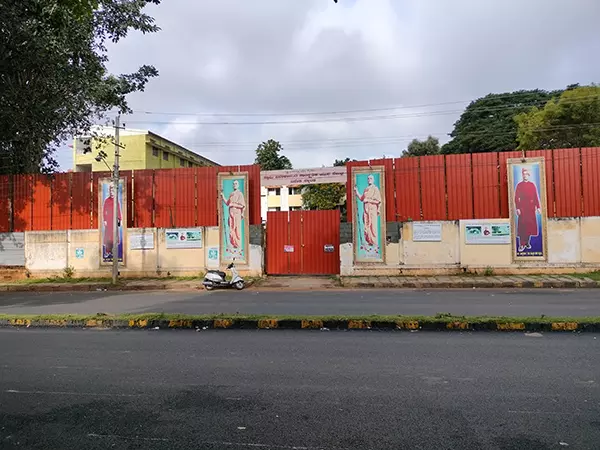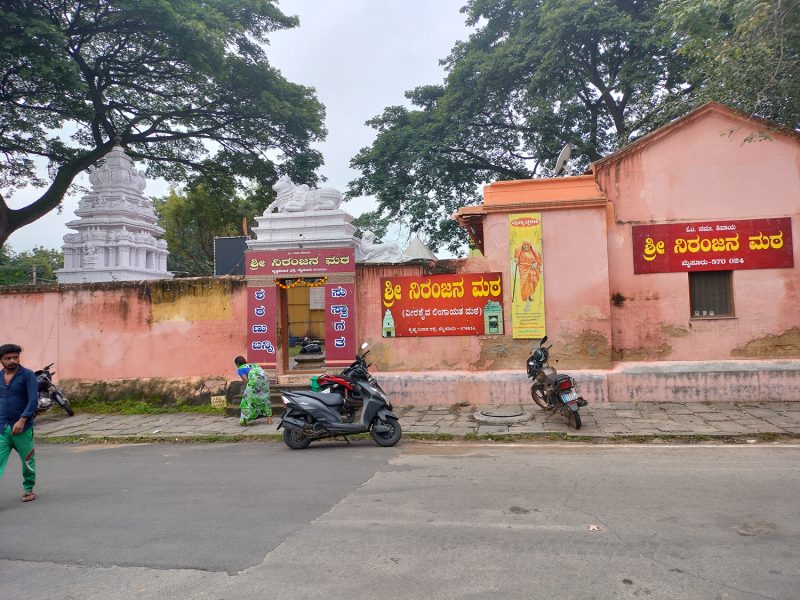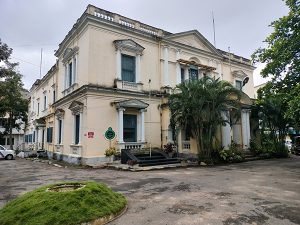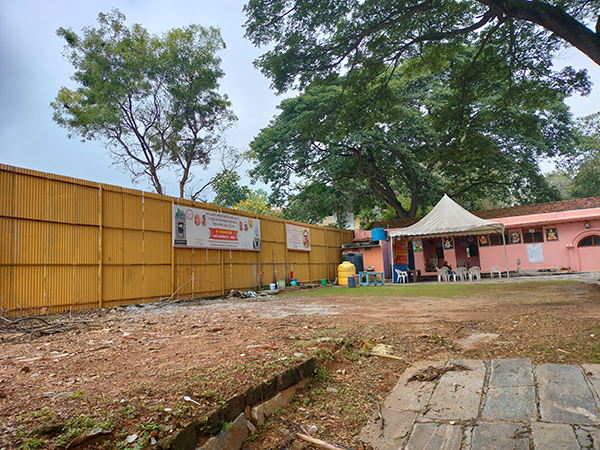
Lingayats, Sangh Parivar lock horns over Vivekananda memorial in Mysuru
Dispute over land for the memorial could cost the BJP dearly, for the Lingayats form 15% of the population in Karnataka

A memorial for Swami Vivekananda in Mysuru — proposed by the Centre, state and the Sangh Parivar — has run into long-drawn resistance from several influential groups, the latest one being the Lingayats.
Those opposing the memorial in its current form have taken out massive processions, sat on protests for months and even approached the courts.
Though the young monk had spent only a few weeks in Mysuru in 1892, the town had played an interesting role in his life. It was during his stay there that Vivekananda, then a little-known monk, made up his mind to attend a religious meet in Chicago — a decision that would catapult him to global fame. Impressed by the young ascetic, Maharaja Chamarajendra Wadiyar helped him financially to make the trip.
Also read: BJP’s trust deficit with Lingayats may give Congress a chance in Karnataka
Bone of contention

It is said that Swami Vivekananda initially stayed in a religious building, Niranjana Matha, located on a large plot of land, before shifting to the official residence of Dewan Seshadri Iyer.
Now, a proposal by the Ramakrishna Ashram to build a memorial utilising the Niranjana Matha plot and an adjacent plot has become the bone of contention. As a result, the project has stalled and even the combined might of the governments at the Centre and the state has failed to fast-track it.
The Centre had allotted ₹5 crore in 2014 to build the memorial and sanctioned ₹25 lakh as the first instalment. In 2019, it asked the Ramakrishna Ashram to return the money with interest as the construction work had not begun even after five years.
The project faced resistance from different quarters over the years. Most recently, members of the Akhila Bharatha Veerashaiva Mahasabha, an influential organisation of Lingayats, stepped in to oppose it. Constituting about 15 per cent of the state population, Lingayats are a politically powerful community in Karnataka and they are the main backers of the ruling BJP.
Plan for a grand memorial
The idea for the memorial goes back several decades but gained traction in 2010, when the Manmohan Singh-led UPA government started looking for ways to celebrate the 150th birth anniversary of Swami Vivekananda.
Files moved slowly in Karnataka and, in January 2013, the state cabinet under BJP, then headed by Sadananda Gowda, decided to hand over 36,591.66 sq ft of land adjacent to the Niranjana Matha to Ramakrishna Ashram, free of cost, to construct the memorial. Two Ashram supporters claim a subsequent government order transferred even the Niranjana Matha premises to them, reportedly taking the total area to 46,601 sq ft.
Also read: Yediyurappa-like strong Lingayat leader eludes BJP in Karnataka
Ashrama officials made an elaborate plan for the memorial and proposed to build a large amphitheatre, prayer and yoga halls, a museum, classrooms, a library and a book exhibition in the allotted land.
Intellectuals oppose
But before the work could start, an influential section of state intellectuals, artists and activists approached the courts and protested against the imminent demolition of a Kannada medium school that stood on the allotted land. They said the school — one of the first for girls in the country and started by the Mysuru queen in 1881 — had a heritage value.
Meanwhile, the power in the state shifted to the Congress government under Siddaramaiah, which was sympathetic to the largely left-leaning protesters. It took Ramakrishna Ashram eight years to overcome several bureaucratic and judicial challenges. It secured a favourable verdict in June 2021 from the Karnataka High Court, which upheld the transfer of land and ordered its possession to Ashram officials.
Enter the Lingayats
It was then that the Veerashaiva Mahasabha leaders, who had stayed away from the memorial controversy all those years, decided to step in and spring a surprise.
Several district-level leaders of the influential community claimed that the religious building, Niranjana Matha, which stood on the allotted land, was a Veerashaiva structure. They started campaigning against the handover of the land to Ramakrishna Ashram and filed a writ in the High Court.
“We have challenged the transfer of land as there are serious procedural lapses and lack of clarity,” said TS Lokesh, Veerashaiva Mahasabha’s petitioner at the High Court. “We are also disputing how much land has been transferred to Ramakrishna Ashram. A letter from Mysuru City Corporation dated September 16, 2022, says only 36,591.66 sq ft has been transferred. This excludes the Niranajana Matha premises.”
The protesting Veerashaiva Mahasabha leaders say Niranjana Matha has many insignia like a Basava idol on the main door and a Shivling, which are associated with the Lingayats. There is also an idol of Dakshina Murthy, a form of Shiva, the reigning deity of the community. In addition, they believe there is the tomb of a Lingayat saint; they claim there’s documentary evidence to show it has been worshipped by the community since at least the early 1990s.
The supporters of Ramakrishna Ashram dismiss these claims saying these religious insignia are not exclusive to the Lingayat community.
Three key incidents
The contest for the Niranjana Matha land escalated owing to three incidents. One, Chakravarti Sulibele, a high-profile right-wing ideologue, visited Mysuru in September 2021 and allegedly visited the homes of several Lingayat leaders, requesting their support for the Vivekananda memorial. He also allegedly appeared on a TV channel owned by a BJP minister, arguing his case.
Veerashaiva Mahasabha leaders held a press conference alleging that Sulibele was trying to divide them and disturbing communal harmony by pitching it as a fight between Lingayats and Brahmins. They also criticised the TV channel for airing one-sided views and for not inviting them to debate Sulibele.
“We are only protecting our property and not against any community. This propaganda to paint us in a bad light only firmed up our resolve. There is no going back now,” said Lokesh.
In the second incident, word spread among Lingayats that Ramakrishna Ashram officials were allegedly dismantling a Lingayat saint’s resting place and had removed the Dakshina Murthy idol after gaining possession of the land. In response, hundreds of enraged Veerashaiva Mahasabha members barged into the Matha, evicted a handful of Ramakrishna Ashrama supporters and took possession. They now remain in charge. They allege that Ashrama supporters were trying to remove all the evidence that it was a Lingayat Matha.
D Nagbhushan, a former corporator of the area and a supporter of Ramakrishna Ashram, was amongst those who were evicted. “We complained to the district administration and the police. But everyone said they were helpless as these people are politically powerful. We are not retaliating as we don’t want violence,” he said.
M Doreraju, a devotee of the Ramakrishna Ashram and a retired engineer of the Archaeology Department, denied the Lingayats’ allegations and said the Dakshina Murthy idol had been moved as its foundation was crumbling. “The plan was to build a mandap for the idol and repair the dilapidated temple (dome) without dismantling any existing structure,” he claimed in a press release.
Also read: Lingayat mathas: Agents of change or alternative power centres?
The third incident was the demolition of the Kannada-medium school building. After transferring the students to a nearby school, the city administration sent bulldozers and the police to raze the school down and remove the protesters. “If we had not taken ‘direct action’, the Niranjana Matha and the tomb would have perhaps met the same fate as the school,” claimed a Lingayat activist.
Documentary proof
Supporters of Ramakrishna Ashram say Lingayats do not have any documentary evidence to back their claim of ownership. They say the Matha originally belonged to the Brahmins of the Shankaracharya tradition.
They say Vishveshwarananda Saraswati, a pontiff of the Matha, handed over its property to local dignitaries through a registered trust deed to be run as an orphanage for Hindu children in 1896. Earlier, a resident of the city, Nanjunda Swami alias Niranjana Swami, had willed it to Vishveshwarananda Saraswati, goes their claim.
The Mysuru government under the Maharaja acquired this plot of land around 1916 and shifted the orphanage to a larger site. The trustees of the orphanage were also reportedly paid a compensation of ₹6,000 to make the shift.
A City Improvement Trust Board (CITB) document of 1971, unearthed by RTI activist Arvind Sharma, takes note of these transactions. “It was a Brahmin property that was taken over by the government and then allotted to Ramakrishna Ashrama, No other claim is legally possible,” said Sharma.
Former police officer and Veerashaiva Mahasabha vice-president Shankar Bidari said there was no need for Lingayats to show any documents to prove their ownership over Niranjana Matha. “The physical symbols on the structure are enough to justify our faith and ownership. Are we (Lingayats) so weak that we cannot defend our property?” he asked.
Bidari made these comments while addressing a large meeting in Mysuru on October 9, which was attended by other senior leaders like Eshwara Khandre. This was the first time top Veerashaiva Mahasabha leaders had come out in full force in support of their district colleagues and escalated the issue as the priority agenda of the organisation.
“If anyone tries to grab even a foot of our land, we will start a statewide campaign from different places,” warned Bidari.
Faith of community
“Lingayat mathas are usually properties donated by common people over centuries for a social cause. Many of them do not have proper paperwork and fall prey to land grabbers. Even the Supreme Court’s Ayodhya judgment says the faith of the community has to be considered,” said Lokesh, the petitioner.
Also read: Seer’s arrest: Parties tread with caution fearing Lingayat voters’ ire
“If the Ramakrishna Ashram supporters are debating proof, where is the proof that Swami Vivekananda stayed at the Niranjana Mutt?” he asked.

Nanjaraj Urs, a well-known Mysuru historian, said there is no proof whatsoever that Swami Vivekananda stayed at Niranjana Matha. “Vivekananda Jeevana Charitre, a 1968 book written by Swami Somanathananda, who was a monk at the Ramakrishna Ashrama, says on page 161 that Swami Vivekananda stayed at the neighbouring Seshadri House of the Dewan. This book was published by Ramakrishna Ashram itself. Other literary sources also make the same claim,” he said.
A ‘Berlin wall’ in Mysuru
A visit to the disputed site reveals a 20-feet-tall zinc sheet barricade separating the two pieces of property. The plot allotted to Ramakrishna Ashram is separated from the Niranjan Matha premises, which are currently under the physical possession of Veerashaiva Mahasabha members, a result of their ‘direct action.’

“The district administration set up this ‘Berlin wall’ to separate us. They also deputed a large police team here for two months at the pretext of keeping peace. But we complained to former Legislative Council chairman Basavaraja Horatti, who came to visit us and he got the police evicted,” said a Lingayat leader.
Ramakrishna Ashram supporters are unhappy that the Lingayats’ ‘continued illegal occupation’ of the Niranjana Matha is hampering the memorial work. “We fought in the courts for so many years and won a verdict in our favour. It is a travesty of justice that these trespassers do not respect the judgment. It is for the government to deal with them,” said Swami Muktidananda, president of Ramakrishna Ashram, Mysuru.
Lingayat leaders deny that they have done anything illegal or have slighted the judiciary.
“Our writ is before the High Court and the issue is sub-judice. But they still went ahead and held the ground breaking ceremony for the memorial in July. They were just showcasing their clout in the government and brought in 200 policemen to keep us away. But we will continue to fight legally and peacefully,” emphasised Lokesh.
Suttur Swamy’s role
Ramakrishna Ashram supporters also say the protesting Lingayats do not have much backing in their own community.
“Suttur Deshikendra Swami, a most prominent Lingayat religious leader in the region, took part in the groundbreaking of the memorial. The squatters are just a few and not backed by the majority of Lingayats,” said Nagbhushan, the former corporator.
Lingayats hold their monks in high regard but on this issue Deshikendra Swami seems to be facing flak from his community. “Attending the ceremony was his personal decision and in no way reflects the mood of the community,” said a protesting leader. “The Swami has a vast education empire to protect. The Sangh Parivar is behind the memorial and he is afraid to rub them in the wrong way,” he added.
In a rare public rebuke to the Swami, the Mysuru meet of October 9 discussed his conduct and decided to request him to support the community cause in future.
Offer for alternative memorial site
Lingayat leaders say they respect Swami Vivekananda and are willing to construct a memorial for him on their own or through a trust under their control, but will never agree to transfer the disputed land to Ramakrishna Ashram.
Also read: Janaspandana: A rally of hope for Karnataka BJP in Old Mysuru region
“Seshadri House, which now houses a commercial tax office, even has a board saying Swami Vivekananda stayed there. Why does Ramakrishna Ashram want a huge plot of land, which has nothing to do with Swami Vivekanand? The last thing we need here is a five-star spiritual centre like the ones in Bengaluru or Coimbatore, which cater only to the rich,” said Lokesh, the petitioner.
A BJP politician said: “We have to tread carefully as Lingayats vote for BJP and state elections are fast approaching. We will try to work out a compromise and hope the Lingayats will eventually yield as the rest of the Hindu society is united on the issue.”
“We are in large numbers. If we can bring people and parties to power, we can also bring them down,” said Basavaraj Hinkal, president of the Niranjana Matha Samrakshana Samithi.

